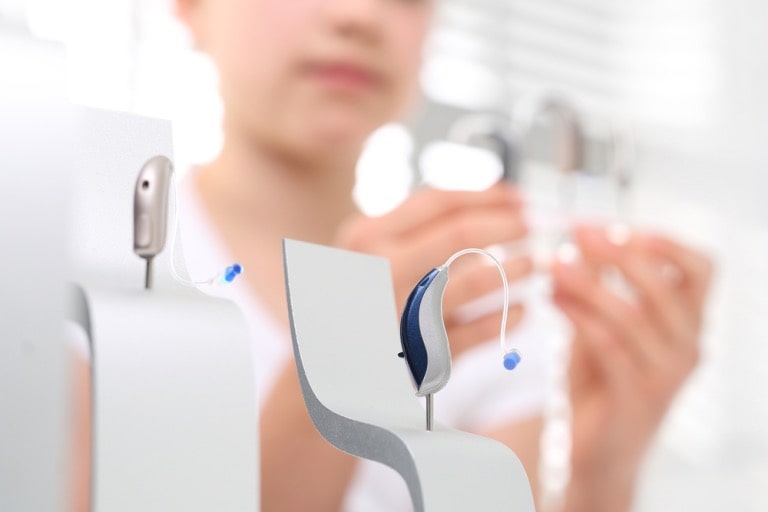Hearing aids are small, battery-operated electronic devices that help the user hear better. Though these gadgets cannot restore normal hearing, they may assist patients with moderate to severe hearing loss improve their hearing.
Most notably, they assist those with sensorineural hearing loss to hear better and communicate with others. But how do hearing aids work exactly? Read on the learn more about these devices and the different types available, as well as their functions.
How Do Hearing Aids Work?
A microphone gathers up sound and transforms it into a digital signal, an amplifier boosts the volume, and a receiver transmits the signal to your ears; together, these components comprise a hearing aid. Modern hearing aids do more than merely amplify sound. They are highly sophisticated means of communication that improve clarity by eliminating extraneous noise and protecting users’ hearing.
Different Parts of a Hearing Aid
Microphone
Microphones in hearing aids pick up sound and transform it into electronic signals. The data is subsequently sent to the amplifier. Many of today’s hearing aids provide switchable directional and omnidirectional microphones.
Amplifier
The amplifier is crucial in making the sound louder. The volume of the amplifier is adjusted according to the degree of hearing loss. Only after an extensive hearing test has been performed by a trained healthcare expert can this be determined. Modern hearing aids may utilize either linear amplification or wide dynamic range compression (WDRC).
Receiver
The sound is sent into the cochlea via the receiver or the speaker. After the electrical signal from the amplifier has been converted back into acoustic energy (sound), it is sent to the inner ear through the speaker. Ear domes or earmolds are used to hold the device. For those with deep to severe hearing loss, earmolds provide the best possible amplification and ear seal compared to domes.
Artificial Intelligence and Custom Programs
There is no one “ideal” hearing aid setting. Today’s hearing aids have artificial intelligence that can be customized to your preferences, so you can hear well even in noisy settings. These programs may be tailored to your specific hearing requirements by your audiologist, but they aren’t comprehensive.
Because you’ll be in a quiet location during the hearing aid exam, the hearing care specialist will have to estimate your preferences for various sound situations. AI can learn about diverse contexts, utilize data from other users, forecast your settings, and automatically change its processing.
What Are the Different Kinds of Hearing Aids?

Hearing aids vary in the sophistication of the technology they use. Due to various causes of hearing loss, several kinds of hearing aids have been developed. How hearing aids function is another subject that varies with the model you choose. Take a hearing test to find out which hearing aid is best for you.
Here is a breakdown of the many hearing aids available and how they function:
- Analog hearing aids. To amplify continuous sounds, analog hearing aids convert them into electrical impulses. Some may be customized to suit a variety of listening conditions thanks to their embedded microchips.
- Digital hearing aids. Computer chips in digital hearing aids convert sound waves into digital code, making them easier to understand and use. The sound is calibrated by the chips depending on your individual listening preferences, hearing impairment, and environmental noise. These hearing aids, however, do more than just increase the size of the original sound wave during the amplification process; they also allow for more intricate processing of the sound.
- Behind the ear (BTE). This hearing aid fits behind the ear and is positioned above the ear canal. An ear mold, a bespoke earpiece that fits in your ear canal, is attached to the hearing aid through a tube. A hearing loop is common in BTE hearing aids. Transferring voice signals from a mobile phone to your ear is much easier with this function.
- Reciever-in-canal (RIC). RIC hearing aids share many characteristics with behind-the-ear models. The ear canal speaker or receiver is the distinguishing feature.
- In the ear (ITE). One of the most often used styles of hearing aid is the in-the-ear model. Full or partial ear shells may be used according to your preference.
- Canal hearing aids. It is possible to improve mild-to-moderate adult hearing using in-the-canal (ITC) hearing aids, which are partially shaped to fit within the ear canal.
- Completely-in-canal (CIC). These hearing aids are the smallest and most discrete option. Their small size makes them more resistant to wind noise.
Final Thoughts
Modern hearing aids are so sophisticated that they may improve your ability to interpret speech by filtering out background noise and amplifying the voices you wish to hear. As a result, the use of hearing aids can significantly enhance both your auditory experience and your general quality of life.